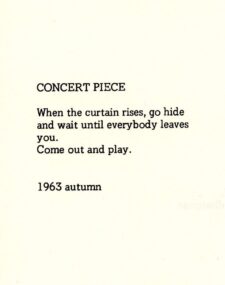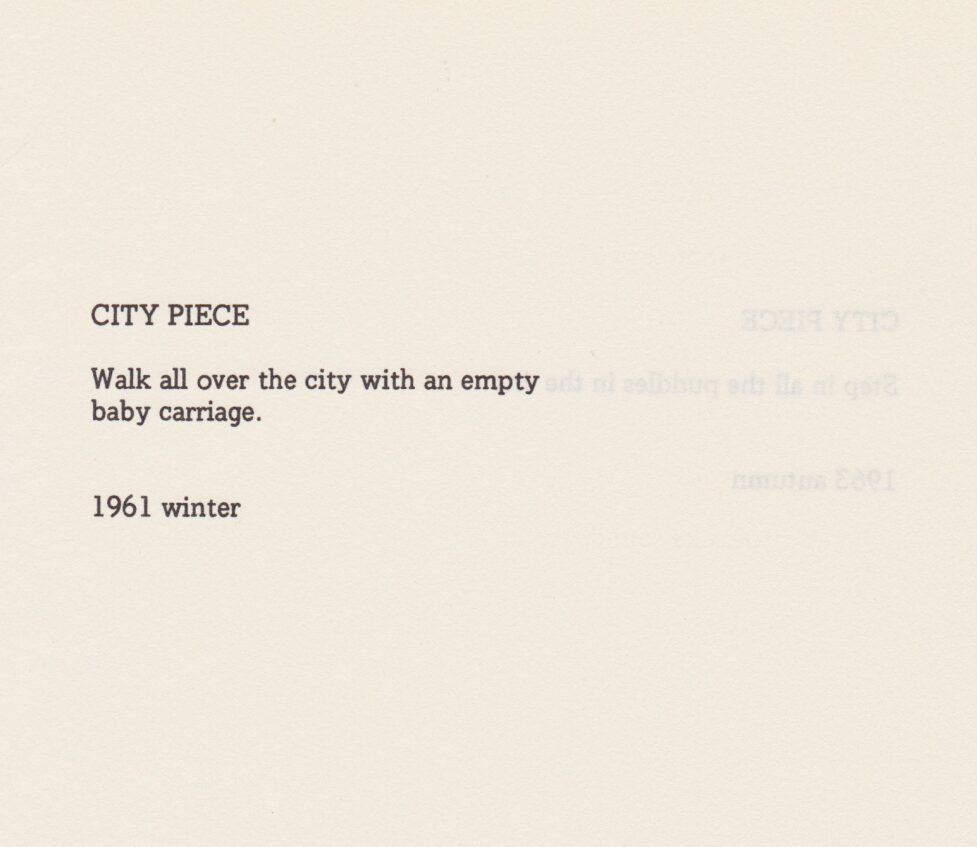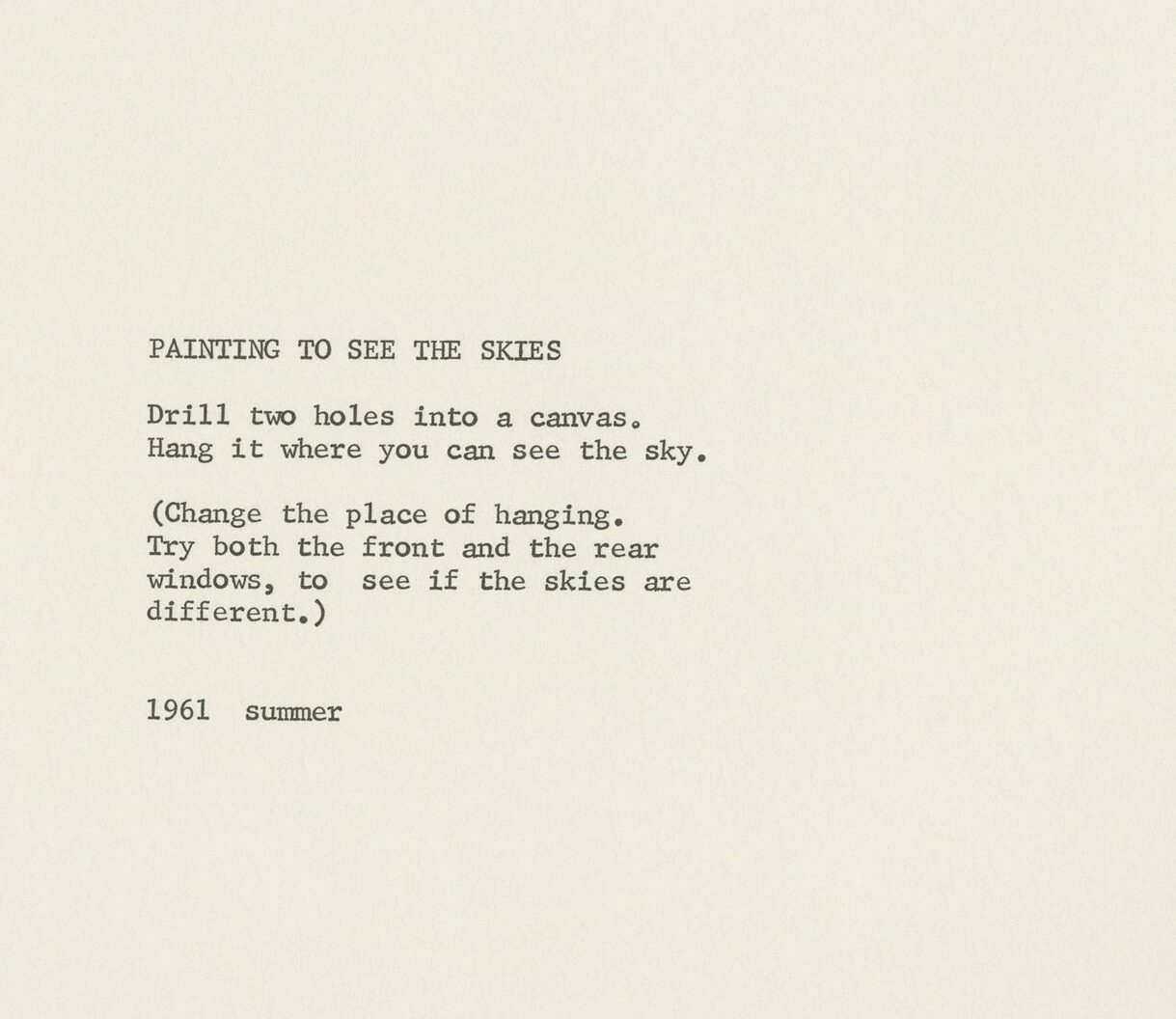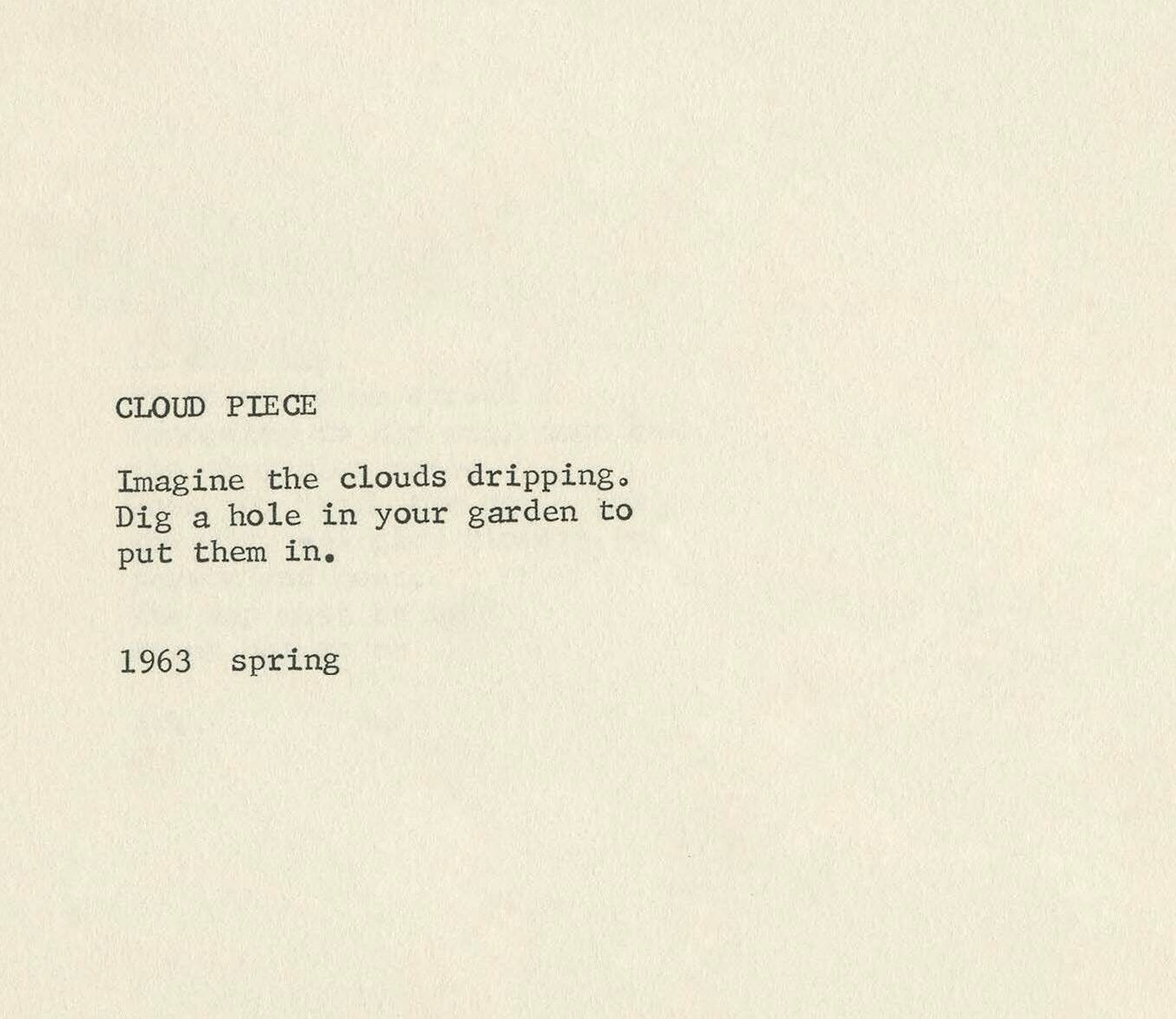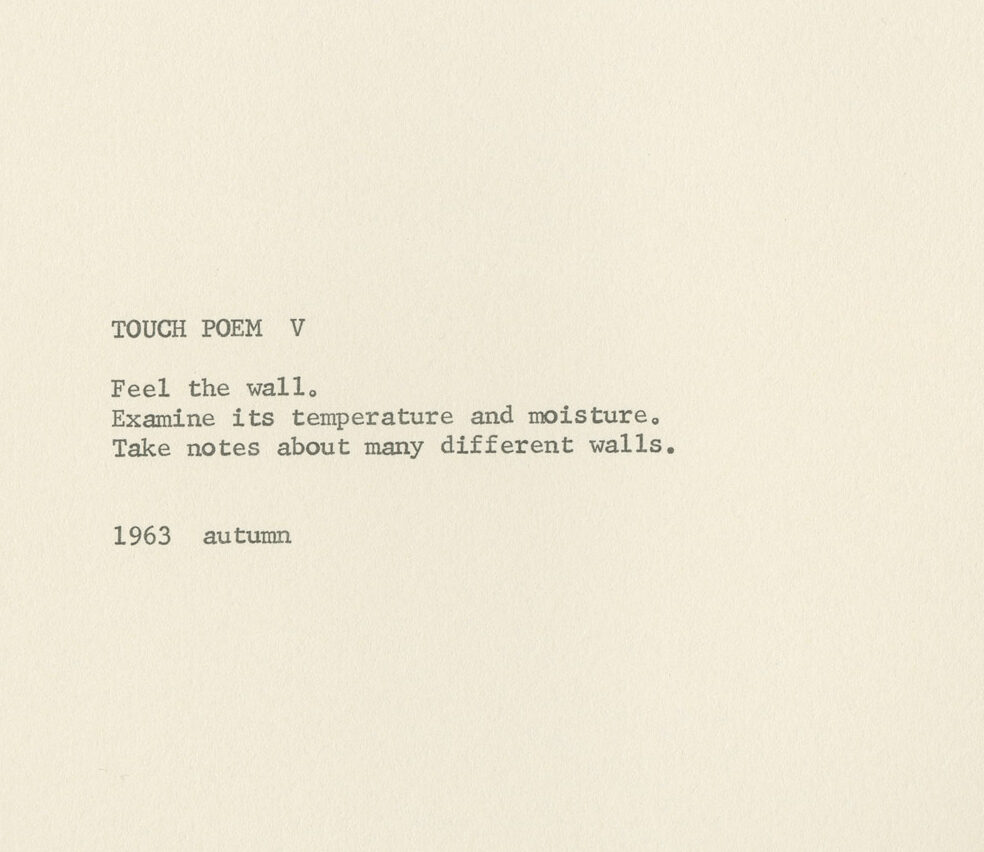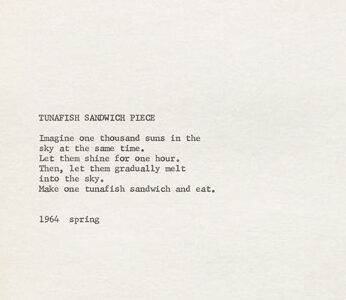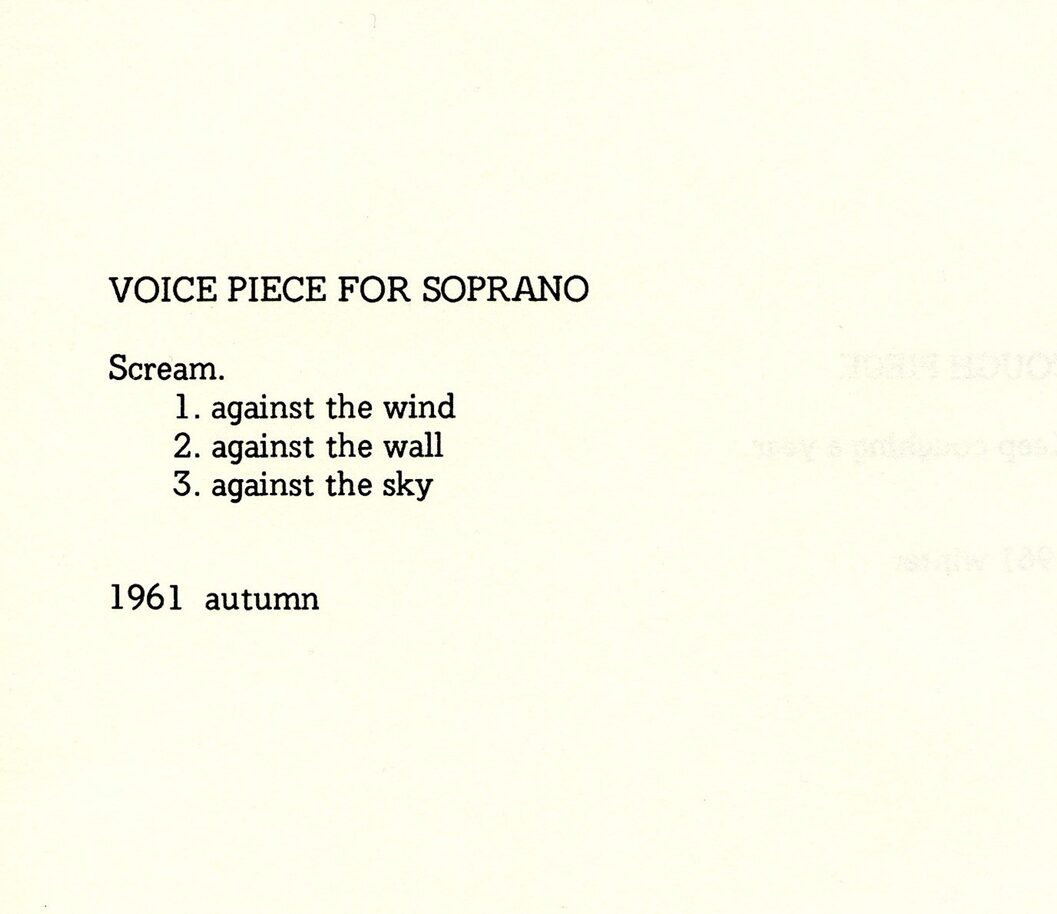In this special issue, we argue that the familiar narrative of the dematerialization of art since the mid-twentieth century has obscured procedural works’ significant relationships to the somatic and to the environment. The essays gathered here, individually and collectively, illuminate embodiment and emplacement as key stakes and concerns within the proceduralist tradition. They identify Cecilia Vicuña, Yoko Ono, Adrian Piper, and Bernadette Mayer as key practitioners of proceduralist aesthetics, and they discuss the material relationships between textualities and bodies within poetry, performance, pedagogy, and playable media.
ASSIMILATING THE ARTS
On Poetry and Difference in Yoko Ono's Grapefruit
Keegan Cook Finberg
This essay argues that Yoko Ono’s midcentury instructions offer a response to changing labor practices and renewed forms of racial capitalism after World War II. I attend to Ono’s instructions written between the U.S. and Japan and perform a reading of her book Grapefruit (Tokyo, 1964), which has previously confounded literary and arts genres. When read as a work of poetry, Grapefruit engages capitalist fictions about race and immigration through attention to scientific management systems promoting shifting productivity and to global models of unevenly distributed life chances. Offering an aesthetic and political philosophy, Grapefruit diverges from both debates about media autonomy, and from philosophies of intermedia, to suggest coalition building across arts and cultures.
ONO OPTICS
Toward a Theory of the Perfectly Unreadable
Jane Malcolm
Yoko Ono was a primary innovator of the event score, a mainstay of procedural poetry from the 1960s and 1970s. Looking closely at Grapefruit: A Book of Instruction and Drawings (1970), alongside Ono's perennial interest in idleness and whimsy, this essay asks how valuing the somatic dimensions of instruction-based poetry challenges our methods of reading and apprehending poetic texts and insists that we distinguish between procedure-as-poem and the speculative text that is created by bodies performing instruction-based poems. The unknowable, unreadable outcomes of these embodied poems become increasingly legible and nuanced as we shift critical focus from the textual to the extra-textual surround in social and pedagogical spaces.
THE DANGER OF THE SITUATION
or, The Indexical Present of Apology in the Performance Artwork of Adrian Piper and Dr. Vaginal Davis
Bellamy Mitchell
This paper traces how the procedural contours of the genre of the apology serve the socially critical and investigative projects of two performance artists who use apologies to navigate, resist, and make politically productive their experiences of being interpolated into white discomfort. I read Adrian Piper’s “Calling Cards” (1986-1990) as procedural texts at the intersection of apology and command, which activate postures of deference and aggression in those who receive the cards, and relate these performances to an apology delivered by Vaginal Davis. I draw out an account of the apology as an indexical genre that brings forms and fictions of relating into relief, and that activate emotions around senses of individual and collective responsibility.
ADRIAN PIPER
Procedure, Intimate Inquiry, Archives
Julia Polyck-O’Neill
Adrian Piper seeks to establish her position in the face of her marginalized identity by developing her work as a kind of broader informational, archival project – a project enhanced by the creation of her own physical and digital archive. Considering Julietta Singh’s proposition that “the archive is a stimulus between myself and myself,” I attend to how Piper’s artworks – in particular her Catalysis performances (1970s) and the My Calling (Card) series (1986 and 1990) – foreground questions about subjectivity and agency within Piper’s life and practice as modes that represent the entanglement of philosophical inquiry and art making. Piper’s outputs demonstrate a need to situate herself, as a thinking and embodied entity, in the art world and in the world in general.
QUIPU PROCEDURE
Jena Osman
This piece is a textual quipu, where sequences of knots (in the form of footnotes) connect [1] an ancient data collection technology as used by the poet-artist Cecilia Vicuna to [2] contemporary algorithms that collect and sort the data produced by living bodies to [3] glitches in machine translation algorithms. It is recommended that you click on the footnotes as you come upon them.
POETIC DIANOIA
Epistemic Injustice and CA Conrad’s (Soma)tics
Stephen Ross
This essay thinks the confluence of two concepts, epistemic injustice and poetic dictation, in the work of CA Conrad. Epistemic injustice is a concept invented by the analytic feminist philosopher Miranda Fricker that concerns forms of harm people suffer in their capacity as knowers. Poets, since Plato, have been seen as precarious subjects of knowledge. My wager is that Conrad critically redeems Plato’s degraded model of the poet – as an ignorant mineral body magnetized by a lodestone – not by refusing it but by literalizing it. In doing so, Conrad’s “(Soma)tic rituals” rhapsodically expose violence inherent to the field of social knowing.
SHE RIPPLES HAPPILY
Coding Hormone Care in Porpentine Charity Heartscape’s With Those We Love Alive
Julie Funk
While hormones are commonly referred to as “chemical messengers,” this article extends this understanding of hormones as communicative agents to variables in computer code. I situate my reading of hormone variables through Porpentine Charity Heartscape’s interactive fiction, With Those We Love Alive (2014). Through what micha cárdenas calls algorithmic analysis, I examine how the variable status of Porpentine’s encoded hormones affects the both player and the playable character within the online narrative’s authoritarian context. Though the encoded hormones are capable of reproducing a disciplined transgender body, a slimy, oozing easter egg is there to recuperate trans care and community as an outcome of the informatic networks through which hormones flow.
WORLDS WITHOUT AN I
Bernadette Mayer’s Procedural Lyric
Julia Bloch
This essay contends that the site-specific procedural texts of Bernadette Mayer constrain and animate the expressive and cognitive textures of the speaking I. In their prescriptive qualities, their ambivalent posture toward authorial intention and embodiment, and their animation of the expressive capacities of built environments, site-specific procedural texts like Mayer’s 1971 work Memory investigate not only the complexities of first-person expression in poetic and visual forms but also the apparent hermeticism of the individual mind. The radically inclusive documentary practices of Memory, followed decades later by the polyvocal and synaesthetic poetics of 2019’s Poems (in Color), constitute two instances of procedural poetics alert to how lyricism can be understood as a social form.
SPELL AND SURVIVAL TECHNIQUES
Dreams as Procedure in Lyn Hejinian and Jackie Wang’s Poetry
Margaret Ronda
This essay turns to two contemporary poetic texts, Lyn Hejinian’s The Book of a Thousand Eyes (Omnidawn, 2012) and Jackie Wang’s The Sunflower Cast a Spell to Save Us From the Void (Nightboat, 2020), that turn to the unconscious processes of the mind at rest and the forms of materialist attention that they generate. These texts attend to the terrain of work and social reproduction as reflected and refracted in the realm of dream. I argue that rather than framing sleep and dream as interior spaces where solitary fantasies and attachments play out, these books insist on the active interplay between the social and the dreamworld and the material action of dream and sleep.




